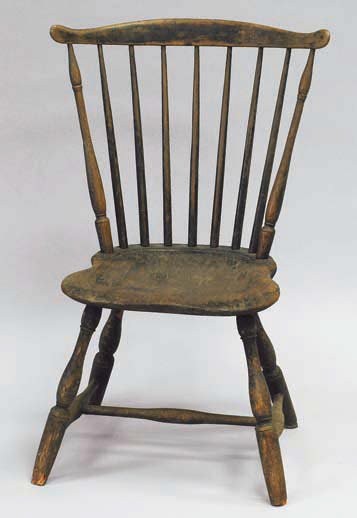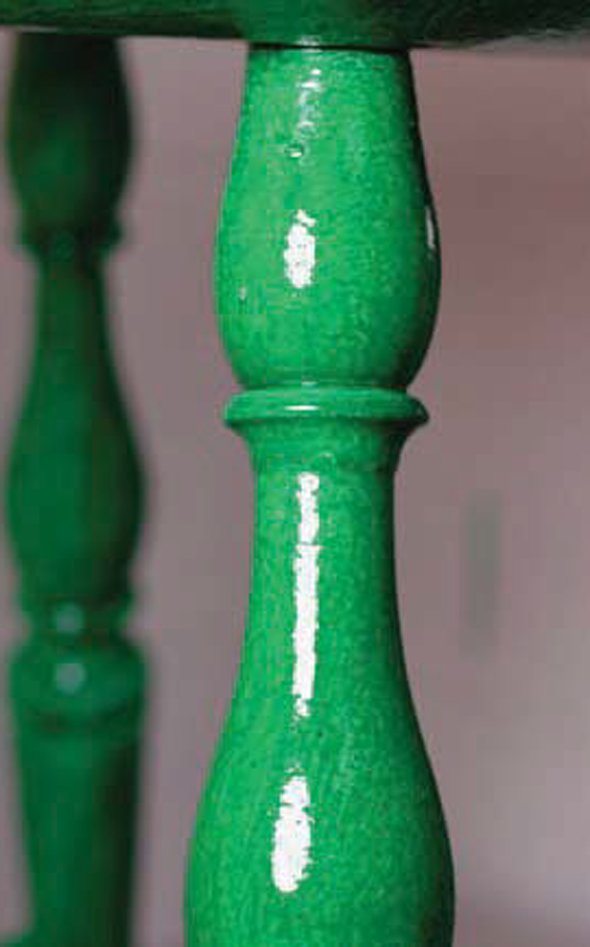Green Your Home with Antiques: Going Green in the Eighteenth Century -- Understanding Original Windsor Furniture Color
 |
 |
Much of the recent research into the colors used in eighteenth-century American Colonial interiors has revealed a brighter color palette than the muted tones made popular in the Colonial Revival period. New methods of paint analysis have uncovered evidence of bright green painted rooms in historic houses such as Gunston Hall, Mount Vernon, and Colonial Williamsburg's Thomas Everhard House. These discoveries led us to wonder if similar bold colors might also be found in representative painted furniture, especially Windsor chairs, of the period.
Eighteenth-century Windsor chairs have been traditionally studied from the standpoint of their design and formal characteristics. Regional associations have been established based on the style of the turnings, carving, and specific dimensional relationships. However, until the time of the Revolution, American Windsor furniture was almost exclusively painted green.1 Period formulas used by painter-stainers or colormen reflect the almost exclusive preference of green for Windsors, reflecting an association with nature whether used indoors or outdoors in the garden. The vast majority of these green formulas refer to verdigris — a mixture of various copper acetates — as the preferred green pigment. As with other dry pigments in the period, verdigris was mulled with a drying oil such as linseed oil to form a paint. Paints were mixed as needed, and so the exact colors obtained depended on the source and purity of the pigments as well as the proportions used.
 | |
| Fig. 1: Windsor side chair, labeled by Robert & Andrew McKim, Richmond, Va., 1795-1805. Colonial Williamsburg Foundation. 1990-154, 1. |
Despite its initial bright blue-green color, Verdigris was known to turn brown and eventually black in an acidic medium such as linseed oil and in the presence of light and oxygen (a process known as photo-oxidation). The green oil paint was often coated or even mixed with a glossy varnish medium that slowed this conversion process. The resultant mixtures are known as copper resonates, pigmented varnishes, or simply, glazes. But even with a glaze, eventually the paint darkened. It is not uncommon to find several coats of old paint on Colonial-era Windsors — the later paint often mimicking, not the original bright paint, but the degraded darker color. This is the most likely reason why we find furniture with more recent dark gray and black paint over oxidized, originally bright green paint.
Because seating frames were often repainted throughout their lifetimes, and many frames were stripped outright in the early twentieth century, chairs thought to retain original paint layers are extremely rare. In the Colonial Williamsburg collection, only three out of an initial study group of about two dozen eighteenth- and early-nineteenth-century Windsors were found to have early paint histories beneath later paint.
Green Paint Used on Windsor Reproductions
As a result of the recent investigation, two reproduction Windsor chairs at Colonial Williamsburg are being reinterpreted as repainted chairs, as many were in the period. Their new green paint mimics the paint found on the pair of labeled Andrew and Robert McKim Windsors from Richmond, Virginia, 1795-1805, and is also based on recipes for green paint from the eighteenth- and early nineteenth century2 (Figs. 1, 2). What survives of the original McKim paint, buried at the lowest level, is a verdigris green pigmented semi-glaze on top of a light-gray ground. Like historic green glaze-paint formulas, ours also features a mixture of verdigris green pigment, linseed oil, and varnish resin. The amount of each ingredient was somewhat experimental, as was the extent of pigment grinding, as is also reflected in the old recipes.
 |
| Fig. 2: Detail of McKim chair with black re-paint. |
The makeup of the green coating on the reproduction chairs was as follows: A ground was laid in a linseed oil/ alkyd resin white paint, with a little lamp black added to make a light gray primer. This was done to approximate a linseed oil and white lead-based eighteenth-century primer, since the use of poisonous lead or other toxic pigments used in period paint is not advisable in new formulas.
A green semi-glaze paint was made by mixing un-ground verdigris, boiled linseed oil, rosin, Venice turpentine resin, turpentine spirits, and some oxidized black-colored thick turpentine (simulating a cruder period turpentine). The ingredients were heated over an open fire outdoors for about two hours, brought to a boil, then removed and cooled. The resulting copper-resinate was a beautiful blue-green syrup-like mixture with a heavy sediment of pigment.
 |  | |
| Left: Fig. 3: Detail of newly re-painted reproduction. Right: Fig. 4: Overall of one of the reproduction Windsors with new green paint. | ||
The formula was adapted slightly in order to speed the drying time for a public presentation. First, zinc and kaolin white pigments were added to give a little more body to the glaze. The lightly mulled (ground) modern verdigris and zinc white pigment in the formula yields a granular character to the paint like that in the period paint. A lead-free drier was added to the semi-glaze, and finally, a quick-drying gloss polyurethane varnish was added to the mixture, which was applied on the chairs in two coats (Figs. 3, 4).
While historical research alone attempts to shape a better understanding of period practices, we cannot fully understand them without corroborating physical analysis of the original objects. The process of reproducing the techniques further reinforces our appreciation of the Colonial period decoration. Research and experiments such as these conducted in the furniture conservation laboratories at Colonial Williamsburg, although merely scratching the surface, hope to contribute new insights into the colorful world of our colonial past. So when you next find yourself wandering the streets of Colonial Williamsburg, stop into the Wig Shop, where our two bright green Windsors are used, and let us know what you think of them. But don't wait too long, or they may appear to be a dull, dark color!
1. Nancy Goyne Evans, Windsor Chair Making In America (University Press of New England, 2006), 144.
2. Ronald L. Hurst, and Jonathan Prown, Southern Furniture 1680-1830 (Colonial Williamsburg, 1998), cat. 46.
Christopher Swan is conservator of furniture at the Colonial Williamsburg Foundation, Williamsburg, Virginia.
This article was originally published in the 8th Anniversary/Spring 2008 issue of Antiques & Fine Art magazine, a fully digitized version of which is available at www.afamag.com. AFA is affiliated with Incollect.com.
 |































